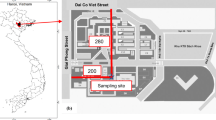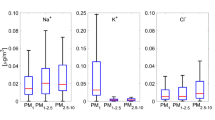Abstract
Size distribution of PM10 mass aerosols and its ionic characteristics were studied for 2 years from January 2006 to December 2007 at central Delhi by employing an 8-stage Andersen Cascade Impactor sampler. The mass of fine (PM2.5) and coarse (PM10−2.5) mode particles were integrated from particle mass determined in different stages. Average concentrations of mass PM10 and PM2.5 were observed to be 306 ± 182 and 136 ± 84 μg m−3, respectively, which are far in excess of annual averages stipulated by the Indian National Ambient Air Quality Standards (PM10: 60 μg m−3 and PM2.5: 40 μg m−3). The highest concentrations of PM10−2.5 (coarse) and PM2.5 (fine) were observed 505 ± 44 and 368 ± 61 μg m−3, respectively, during summer (June 2006) period, whereas the lower concentrations of PM10−2.5 (35 ± 9 μg m−3) and PM2.5 (29 ± 13 μg m−3) were observed during monsoon (September 2007). In summer, because of frequent dust storms, coarse particles are more dominant than fine particles during study period. However, during winter, the PM2.5 contribution became more pronounced as compared to summer probably due to enhanced emissions from anthropogenic activities, burning of biofuels/biomass and other human activities. A high ratio (0.58) of PM2.5/PM10 was observed during winter and low (0.24) during monsoon. A strong correlation between PM10 and PM2.5 (r 2 = 0.93) was observed, indicating that variation in PM10 mass is governed by the variation in PM2.5. Major cations (NH4 +, Na+, K+, Ca2+ and Mg2+) and anions (F−, Cl−, SO4 2− and NO3 −) were analyzed along with pH. Average concentrations of SO4 2− and NO3 − were observed to be 12.93 ± 0.98 and 10.33 ± 1.10 μg m−3, respectively. Significant correlation between SO4 2− and NO3 − in PM1.0 was observed indicating the major sources of secondary aerosol which may be from thermal power plants located in the southeast and incomplete combustion by vehicular exhaust. A good correlation among secondary species (NH+, NO3 − and SO4 2−) suggests that most of NH4 + is in the form of ammonium sulfate and ammonium nitrate in the atmosphere. During winter, the concentration of Ca2+ was also higher; it may be due to entrainment of roadside dust particles, traffic activities and low temperature. The molar ratio (1.39) between Cl− and Na+ was observed to be close to that of seawater (1.16). The presence of higher Cl− during winter is due to western disturbances and probably local emission of Cl− due to fabric bleaching activity in a number of export garment factories in the proximity of the sampling site.






Similar content being viewed by others
References
Ali K, Momin GA, Tiwari S, Safai PD, Chate D, Rao PSP (2004) Fog and precipitation chemistry at Delhi, North India. Atmos Environ 38:4215–4222
Awasthi A, Agarwal R, Mittal SK, Singh N, Singh K, Gupta PK (2011) Study of size and mass distribution of particulate matter due to crop residue burning with seasonal variation in rural area of Punjab. India J Environ Monit 13:1073–1081
Balachandran S, Meena BR, Khillare PS (2000) Particle size distribution and its elemental composition in the ambient air of Delhi. Environ Int 26:49–54
Beate LG (2002) Observed reductions of surface solar radiation at sites in the United States and worldwide from 1961 to 1990. Geophys Res Lett 29(10):1421. doi:101029/2002GL014910
Brauer M, Hrubá F, Mihalíková E, Fabiánová E, Miskovic P, Plziková A, Lendacká M, Vandenberg J, Cullen A (2000) Personal exposure to particles in Banská Bystrica, Slovakia. J Expo Anal Environ Epidemiol 10(5):478–487
Chow JC, Engelbrechet JP, Freeman NCG, Hashim JH, Jantunen M, Michand JP, Tejada SSD, Watson JG, Wei F, Wilson WE, Yasuno M, Zhu T (2002) Chapter one: exposure measurements. Chemosphere 49:873–901
Das M, Maiti SK, Mukhopadhyay U (2006) Distribution of PM25 and PM10−25 in PM10 fraction in ambient air due to vehicular pollution in Kolkata megacity. Environ Monit Assess 122:111–123
Guttikunda SK, Gurjar BR (2011) Role of meteorology in seasonality of air pollution in megacity Delhi, India. Environ Monit Assess. doi:10.1007/s10661-011-2182-8
Hildemann LH, Markowshi GR, Cass GR (1991) Chemical composition of emissions from urban sources of fine organic aerosol. Environ Sci Technol 25:744–759
Int Panis L, de Geus B, Vandenbulcke G, Willems H, Degraeuwe B, Bleux B, Mishra V, Thomas I, Meeusen B (2010) Exposure to particulate matter in traffic: a comparison of cyclists and car passengers. Atmos Environ 44:2263–2270
IPCC (2007) Intergovernmental panel on climate change, fourth assessment report. Cambridge University Press Cambridge Section 22 37
Jain M, Kulshrestha UC, Sarkar AK, Parashar DC (2000) Influence of crustal aerosols on wet deposition at urban and rural sites in India. Atmos Environ 34:5129–5137
Kapoor RK, Singh G, Tiwari S (1992) Ammonia concentration vis-a-vis meteorological conditions at Delhi. India Atmos Res 28:1–9
Kaupp H, McLachlan MS (1999) Atmospheric particle size distributions of polychlorinated dibenzo-p-dioxins and dibenzofurans (PCDD/Fs) and polycyclic aromatic hydrocarbons (PAHs) and their implications for wet and dry deposition. Atmos Environ 33:85–95
Khemani LT (1989) Physical and chemical characteristics of atmospheric aerosols: encyclopedia of environmental control technology: air pollution control written by paul cheremisinoff, Gulf Publishing company 2: 401–446
Khemani LT, Naik MS, Momin GA, Kumar PS, Chatterjee RN, Singh G, Murty BhVR (1985) Trace elements in the atmospheric aerosols at Delhi, North India. J Atmos Chem 2:273–285
Khemani LT, Momin GA, Rao PSP, Safai PD, Prakash P (1987) Influence of alkaline particulates on the chemistry of fog water at Delhi, North India. Water Air Soil Pollut 34:183–189
Kleeman MJ, Cass GR (1998) Source contributions to the size and composition distribution of urban particulate air pollution. Atmos Environ 32:2803–2816
Kocak M, Mihalopoulos N, Kubilay N (2007) Contributions of natural sources to high PM10 and PM2:5 events in the Eastern Mediterranean. Atmos Environ 41(2007):3806–3818
Kulshrestha UC, Kumar N, Saxena A, Kumari MK, Srivastava SS (1995) Identification of nature and source of atmospheric aerosols near Taj Mahal (Agra). Environ Monit Assess 34:1–11
Kulshrestha UC, Saxena A, Kumar N, Kumari KM, Srivastava SS (1998) Chemical composition association of size differentiated aerosols at a suburban site in a semi arid tract of India. J Atmos Chem 29:109–118
Kulshrestha A, Satsangi PG, Masih J, Taneja A (2009a) Metal concentration of PM25 and PM10 particles and seasonal variations in urban and rural environment of Agra. India Sci Total Environ 407:6196–6204
Kulshrestha UC, Reddy LAK, Satyanarayana J, Kulshrestha MJ (2009b) Real-time wet scavenging of major chemical constituents of aerosols and role of rain intensity in Indian region. Atmos Environ 43:5123–5127
Kumar R, Srivastava SS, Kumari KM (2007) Characteristics of aerosols over suburban and urban site of Semiarid region in India: seasonal and spatial variations. Aerosol Air Qual Res 7:531–549
Lee SC, Cheng Y, Ho KF, Cao JJ, Louie PKK, Chow JC, Watson J (2006) PM1 and PM25 characteristics in the roadside environment of Hong Kong. Aerosol Sci Technol 40:157–165
Mahadevan TN (1986) PhD thesis, University of Bombay
Mozurkewich M (1993) The dissociation constant of ammonium nitrate and its dependence on temperature, relative humidity and particle size. Atmos Environ 27a:261–270
Nair PR, George SK, Sunilkumar SV, Parameswaran K, Jocab S, Abraham A (2006) Chemical composition of aerosols over peninsular India during winter. Atmos Environ 40:6477–6493
Norman M, Das SN, Pillai AG, Granat L, Rodhe H (2001) Influence of air mass trajectories on the chemical composition of precipitation in India. Atmos Environ 35:4223–4235
Pandithurai G, Dipu S, Dani KK, Tiwari S, Bisht DS, Devara PCS, Pinker RT (2008) Aerosol radiative forcing during dust events over New Delhi, India. J Geophys Res 113:D13209. doi:10.1029/2008JD009804
Parmar RS, Satsangi GS, Kumari M, Lakhani A, Srivastava SS, Prakesh S (2001) Study of size distribution of atmospheric aerosol at Agra. Atmos Environ 35:693–702
Pipal AS, Kulshrestha A, Taneja A (2011) Characterization and morphological analysis of airborne PM2.5 and PM10 in Agra located in north central India. Atmos Environ 45(21):3621–3630
QUARG (1996) Third report of the quality of urban air review group. University of Birmingham May, Birmingham
Rajsic SF, Tasic MD, Novakovic VT, Tomasevic MN (2004) First assessment of the PM10 and PM2.5Particulate level in the ambient air of Belgrade City. Environ Sci Pollut Res 11(3):158–164
Ramachandran S, Rajesh TA (2007) Black carbon aerosol mass concentrations over Ahmedabad, an urban location in western India: comparison with urban sites in Asia, Europe, Canada, and the United States. J Geophys Res 112:D06211
Rastogi N, Sarin MM (2005) Long-term characterization of ionic species in aerosols from urban and high-altitude sites in western India: role of mineral dust and anthropogenic sources. Atmos Environ 39:5541–5554
Safai PD, Khemani LT, Momin GA, Rao PSP, Pillai AG (1993) Mass size distribution and chemical composition of aerosols at the Silent Valley, India. Indian J Radio Space Phys 22:56–61
Sandberg JS, Levaggi DA, DeMandel RE, Siu W (1976) Sulfate and nitrate particulates as related to SO2 and NOX gases and emissions. J Air Pollut Control Assoc 26:559–564
Seinfeld J, Pandis S (1998) Air pollution to climate change. Atmospheric Chemistry and Physics, Wiley New York
Sharma M, Maloo S (2005) Assessment of ambient air PM10 and PM2.5 and characterization of PM10 in the city of Kanpur, India. Atmos Environ 39(2005):6015–6026
Sharma SK, Datta A, Saud T, Saxena M, Mandal TK, Ahammed YN, Arya BC (2010) Seasonal variability of ambient NH3, NO, NO2 and SO2 over Delhi. J Environ Sci (China) 22(7):1023–1028
Singh T, Khilare PS, Shridhar V, Agarwal T (2008) Visibility impairing aerosols in the urban atmosphere of Delhi. Environ Monit Assess 141:67–77
Spindler G, Müller K, Brüggemann E, Gnauk T, Herrmann H (2004) Long-term size segregated characterization of PM10, PM25 and PM1 at the IfT research station Melpitz downwind of Leipzig, Germany. Atmos Environ 38:5333–5347
Srivastava A, Jain VK (2007) Size distribution and source identification of total suspended particulate matter and associated heavy metals in the urban atmosphere of Delhi. Chemosphere 68:579–589
Stull R (1988) An introduction to boundary layer meteorology. Springer, New York
Tang A, Zhuang G, Wang Y, Yuan H, Sun Y (2005) Seasonal trends in PM25 source contributions in Beijing, China. Atmos Environ 39:3397–3406
Tiwari S, Kulshrestha UC, Padmanabhamurty B (2007) Monsoon rain chemistry and source apportionment using receptor modeling in and around National Capital Region (NCR) of Delhi, India. Atmos Environ 41:5595–5604
Tiwari S, Srivastava AK, Bisht DS, Bano T, Singh S, Behura S, Srivastava MK, Chate DM, Padmanabhamurty B (2010) Black carbon and chemical characteristics of PM10 and PM2.5 at an urban site of North India. J Atmospheric Chem 62(3):193–209
Tiwari S, Payra S, Mohan M (2011) Visibility degradation during foggy period due to anthropogenic urban aerosol at Delhi, India. Atmospheric Pollut Res 2:116–120
Tripathi BD, Chaturvedi SS, Tripathi RD (1996) Seasonal variation in ambient air concentration of nitrate and sulfate aerosols in a tropical city, Varanasi. Atmospheric Environ 30:2773–2778
Tsai YI, Lin YH, Lee SZ (2003) Visibility variation with air qualities in the metropolitan area in southern Taiwan. Water Air Soil Pollut 144:19–40
Wang J, Hu Z, Chen Y, Chen Z, Xu S (2013) Contamination characteristics and possible sources of PM10 and PM2.5 in different functional areas of Shanghai, China. Atmospheric Environ 68:221–229
Weatherburn MW (1967) Phenol-hypochlorite reaction for determination of ammonia. Anal Chem 39:971–974
Acknowledgments
Authors are thankful to the Director, National Physical Laboratory (Council of Scientific and Industrial Research, Ministry of Science and Technology, Govt. of India) for his financial support and encouragement. Authors are also thankful to all staff members of Analytical Chemistry Division, NPL for their moral support and valuable suggestions.
Author information
Authors and Affiliations
Corresponding author
Rights and permissions
About this article
Cite this article
Singh, K., Tiwari, S., Jha, A.K. et al. Mass-size distribution of PM10 and its characterization of ionic species in fine (PM2.5) and coarse (PM10−2.5) mode, New Delhi, India. Nat Hazards 68, 775–789 (2013). https://doi.org/10.1007/s11069-013-0652-8
Received:
Accepted:
Published:
Issue Date:
DOI: https://doi.org/10.1007/s11069-013-0652-8




